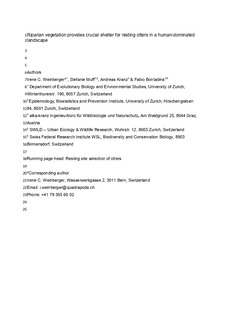| dc.contributor.author | Weinberger, Irene | |
| dc.contributor.author | Muff, Stefanie | |
| dc.contributor.author | Kranz, Andreas | |
| dc.contributor.author | Bontadina, Fabio | |
| dc.date.accessioned | 2020-01-23T13:50:33Z | |
| dc.date.available | 2020-01-23T13:50:33Z | |
| dc.date.created | 2019-09-06T08:47:12Z | |
| dc.date.issued | 2019 | |
| dc.identifier.issn | 1616-5047 | |
| dc.identifier.uri | http://hdl.handle.net/11250/2637693 | |
| dc.description.abstract | The riparian vegetation belt is one of the few remaining structures that provide coverage for wildlife in many anthropogenic landscapes. It provides shelter for many species and functions as corridors for dispersal. However, this landscape is increasingly utilised by humans for leisure activities. The loss of riparian vegetation with a concurrent increase of human disturbance in these habitats can pose a serious threat to wildlife.
One of the species potentially affected is the Eurasian otter Lutra lutra. In the Alps, otters are nocturnal and rest during the day when human activity is high. To study the impact of human presence on resting site selection in otters, we radio-tracked nine otters for up to 30 months in the eastern Central Alps of Austria. We analysed resting site selection in relation to human disturbance.
Altogether, we identified 285 resting sites scattered throughout the territories of the individual otters at an average distance of 144 m between sites. Almost all the resting sites (95%) were located in the natural riparian vegetation, making this the most important habitat for resting otters. We found evidence that human disturbance within these riparian habitats shapes resting site selection. Otters preferred narrow riparian strips when there was no human presence, but selected areas with a wider vegetation belt when the disturbance level increased. Outside the vegetation period, animals rested below ground more often than above, which suggests that vegetation also functions as visual cover.
Our study highlights the importance of the restoration of the natural riparian vegetation belt for the protection of wildlife, particularly where human activities are intense. We provide information for the effective conservation management of otters considering the combination of spatial distribution of resting sites and specific habitat requirements in the presence of human disturbance. Areas of conservation importance chosen in this way are likely to benefit other wildlife that utilise the riparian vegetation belt. | nb_NO |
| dc.language.iso | eng | nb_NO |
| dc.publisher | Elsevier | nb_NO |
| dc.rights | Attribution-NonCommercial-NoDerivatives 4.0 Internasjonal | * |
| dc.rights.uri | http://creativecommons.org/licenses/by-nc-nd/4.0/deed.no | * |
| dc.title | Riparian vegetation provides crucial shelter for resting otters in a human-dominated landscape | nb_NO |
| dc.type | Journal article | nb_NO |
| dc.type | Peer reviewed | nb_NO |
| dc.description.version | acceptedVersion | nb_NO |
| dc.source.volume | 98 | nb_NO |
| dc.source.journal | Mammalian Biology | nb_NO |
| dc.identifier.doi | 10.1016/j.mambio.2019.09.001 | |
| dc.identifier.cristin | 1722113 | |
| dc.description.localcode | © 2019. This is the authors’ accepted and refereed manuscript to the article. Locked until 7.9.2020 due to copyright restrictions. This manuscript version is made available under the CC-BY-NC-ND 4.0 license http://creativecommons.org/licenses/by-nc-nd/4.0/ | nb_NO |
| cristin.unitcode | 194,63,15,0 | |
| cristin.unitname | Institutt for matematiske fag | |
| cristin.ispublished | false | |
| cristin.fulltext | postprint | |
| cristin.qualitycode | 1 | |

